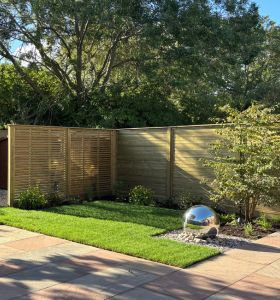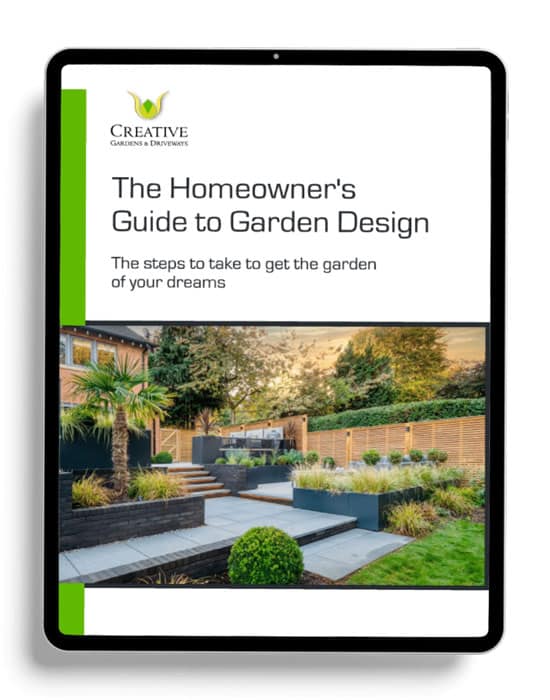How To Successfully Plan Landscape Gardening
Planning a landscape gardening project can be an exciting yet daunting task. Landscaping has the power to transform your outdoor space and bring your vision to life – but only if it is executed well.
This is why planning is so important. With the right approach and expert advice, you can transform your outdoor space into a beautiful and functional area that suits your lifestyle. Whether you are looking to create an entertaining garden for the whole family, a relaxing private retreat or something completely unique no project should get off the ground without a well-thought-out plan.
At Creative Gardens & Driveways, we pride ourselves on delivering high-quality workmanship and ensuring customer satisfaction in everything we do. With over 25 years of experience, we have worked on countless landscaping projects across the North West and continue to be a leading name for this kind of work.
Relying on our skills, experience and passion for landscaping we are offering our top five tips to plan landscape gardening projects.
1. Define Your Goals and Priorities
Before you start any landscaping project, it’s essential to define your goals and priorities. Spending some time considering what you want is going to make the rest of the work easier to complete, as there is a uniform focus.
To plan landscape gardening, you will need to consider what you want to achieve with your garden and what style of landscape will get you there. For example, do you want a space for relaxation, entertainment, or a play area for children?
Taking some time to identify your primary objectives will help you make informed decisions throughout the planning process and make it easier to bring your vision to life.
When planning your landscaping project, consider the following questions:
- What is the main purpose of your garden?
- How much time are you willing to spend on maintenance?
- Do you have any specific plants or features in mind?
By answering these questions as you plan landscape gardening, you can create a clear vision and set realistic expectations for your landscape.
2. Assess Your Space
Understanding the unique characteristics of your garden space is crucial to successfully plan landscape gardening.
The size and structure of your landscape will impact what kind of work can be done in the space and therefore what kind of garden design can be implemented, which is why it needs to be included in your plan for landscape gardening.
Ahead of your planning meeting with landscape gardeners, take the time to assess your garden’s size, shape, and existing features.
During this assessment, also observe how sunlight moves across the area throughout the day and take note of any shaded or overly sunny spots as this can impact the kind of zones you can create in the garden, as well as what kind of plants or features will be most appropriate.
For additional clarification, you can also assess the soil type and drainage conditions across the landscape as these factors will influence plant selection and overall garden design.
You may also want to take measurements and create a scaled drawing of your garden to plan landscape gardening, as this can help to visualise your ideas more effectively. This is something professional landscapers and garden designers, like those on our team, can do on your behalf as they have unique skills in development.
Whatever path you choose, creating a detailed site analysis using these factors will help you make informed decisions and avoid potential challenges later on.
3. Develop a Cohesive Design
Once you have a clear understanding of your garden space to plan landscape gardening, it’s time to develop a cohesive design.
The information you have gained during the site assessments should make this process easier, as you are aware of the limitations of your space and should already have an idea of garden features and zones you want to implement.
A well-thought-out design to plan landscape gardening will ensure that all elements of the garden work harmoniously together to create a visually appealing and functional space.
Developing a cohesive design for your garden is best done in conjunction with experts like those on our team as they have the skills and experience to create attractive, functional gardens in all spaces.
When developing the design for your landscaping project, consider the following design principles to ensure cohesion.
- Unity: Ensure that all elements of your garden work together to create a cohesive look. This can be achieved through the consistent use of materials, colours, and plant varieties in all zones.
- Balance: Create a sense of balance in the garden by distributing visual weight evenly across the space. This can be achieved through symmetrical or asymmetrical arrangements of plants and features.
- Proportion: Ensure that the size of plants and features is in proportion to the overall garden space. Avoid overcrowding or leaving large empty areas.
- Rhythm: Create a sense of movement and flow by repeating elements such as plants, colours, or textures throughout your garden.
Sketching out your design on paper or using digital design tools can help you visualise your ideas and make necessary adjustments before implementation. Working with professional garden designers is also highly useful during this stage of planning for your landscaping project.
4. Choose the Right Plants and Materials
Selecting the right plants and materials is essential for achieving a beautiful and sustainable garden design, and is part of the process to plan landscape gardening.
When choosing plants and planning your landscaping project, you should consider their growth habits, maintenance requirements, and compatibility with your garden’s conditions. This makes it easier to pick the best options for your specific landscape, as well as helps create a cohesive appearance to the space.
It is a good idea to aim for a mix of evergreen and deciduous plants, as this can ensure year-round interest and structure.
For plant selection in your landscaping project, consider:
- Choosing native plants that are well-adapted to your local climate and soil conditions.
- Incorporating a variety of plant types, including trees, shrubs, perennials, and groundcovers, to create a diverse and resilient garden.
- Any seasonal changes and select plants that provide interest in different seasons.
As well as plants in your landscaping project, there are other features you may want to choose and consider. For example, taking the time to carefully choose hardscaping materials such as paving, decking, and garden structures can make a great impression on the finished results.
All materials used in your landscaping project should complement your garden’s style and be durable enough to withstand the elements, offering lasting beauty and functionality.
5. Plan for Maintenance and Sustainability
A successful landscape gardening project doesn’t end with the initial design and installation. Ongoing maintenance is essential for keeping your garden looking its best.
When you plan landscape gardening, you can take things a step further by also planning the kind of maintenance that will be needed. Planning should be done for regular tasks such as watering, pruning, weeding, and fertilising, as well as any additional maintenance that may be needed based on your garden design.
You may want to consider incorporating low-maintenance plants and features when you plan landscape gardening to reduce the amount of time and effort required in the future.
If you are interested in creating a sustainable garden, consider the following:
- Implement water-saving techniques such as mulching, drip irrigation, and rainwater harvesting.
- Use organic fertilisers and pest control methods to minimise chemical use.
- Compost garden waste to improve soil health and reduce waste.
- Choose materials that are environmentally friendly and sourced responsibly.
By planning for maintenance and sustainability, you can ensure that your garden remains healthy and beautiful for years to come and fits in with your lifestyle.
Conclusion
Planning a landscape gardening project can be a rewarding experience. Landscaping can transform your outdoor space into a haven of beauty and functionality when it has been planned well and executed by professionals.
Taking the time to define your goals, assess your space, develop a cohesive design, choose the right plants and materials, and plan for maintenance and sustainability is required to successfully plan landscape gardening. These considerations all you to create a garden that reflects your personal style and meets your needs.
At Creative Gardens & Driveways, we are passionate about helping our clients achieve their dream gardens. We are here to guide you every step of the way and ensure that your garden is a source of joy and pride.
Contact Us Today
Ready to get started? Contact us today to schedule a consultation and begin your landscape transformation!






